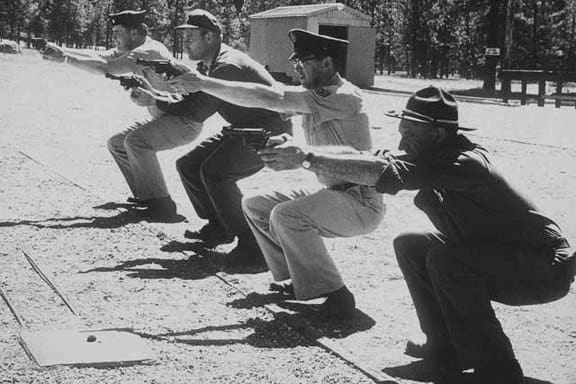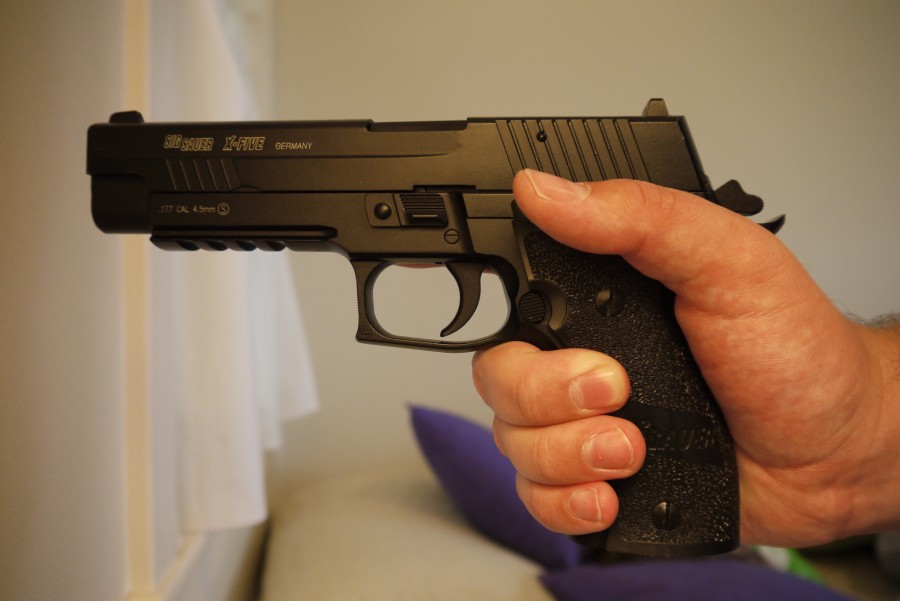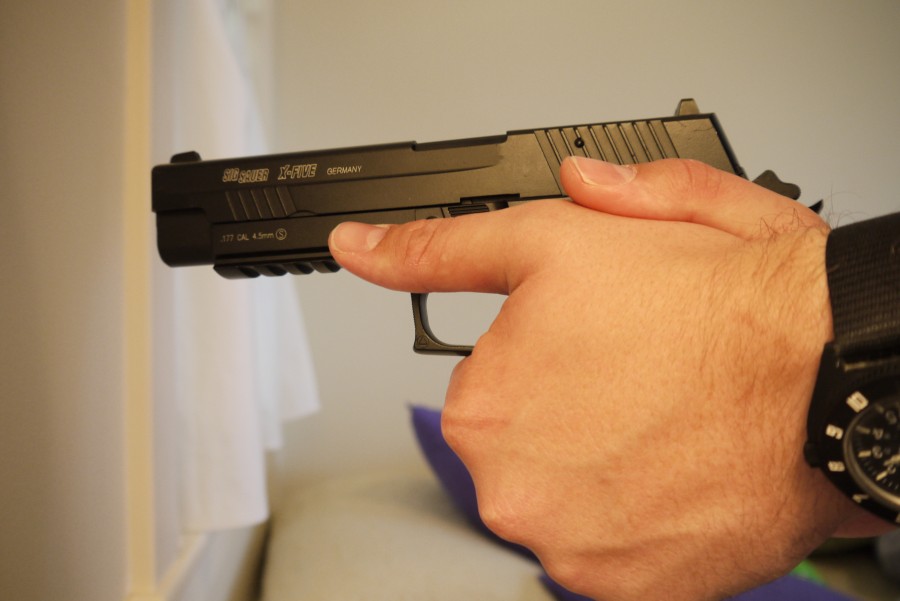William asks:
I have heard of a lot of different techniques but I don’t really understand the advantage of any of them. What are the preferred grips and stances these days, what are the pros and cons? I know I probably have other issues, but I figure I should start with just holding the thing correctly. I would appreciate the help.
This whole “trying to clear out the queue” thing isn’t working. Every time I publish another Ask Foghorn piece and cross it off my list, two more hit my inbox. I’m losing ground. Oh well, such is the life of a TTAG writer. On with the answer . . .
For semi-auto handguns, I keep getting the same answer no matter who I ask. The best and most accurate grip is achieved thusly:
1. Grip the gun firmly with your dominant hand. Your hand should be as far up the gun as possible with the webbing of your hand firmly in contact with the top of the backstrap.
You’ll notice that there is a rather large part of the grip that is left open. The next step is going to be to fill this area with your other hand.
2. Place your other hand alongside the first, rotated about 45 degrees forward compared to the gun. This will place your thumb perfectly in line with the barrel, and should be encouraged to contact the side of the frame. With the palm of your hand you are going to fill that vacant area, contacting the actual grip of the firearm as much as possible. The last step will be to wrap your fingers around your other hand.
The thumb of your weapon hand should be ON TOP of the thumb of your non-weapon hand. This is far more comfortable than the alternative.
For a semi-auto handgun, this gives you the maximum level of control and recoil reduction for your gun. For wheelguns, the same basic process is used except the non-weapon thumb is pulled into the grip instead of extending along the side of the frame.
If you extend your thumb past the cylinder gap, you’re gonna have a bad time of it.
For the stance, the best bet is to place your feet shoulder width apart, face the target directly and extend your arms until they’re just barely bent. A little bend in the knee and you’re good to go.
There are, as always, alternatives. But having tried them all, this is the one I prefer for everything from bullseye shooting to USPSA. Of course, the peanut gallery is sure to prove me wrong.
[Email your firearms-related questions to “Ask Foghorn” via [email protected]. Click here to browse previous posts]







all of these guys look like they are sitting on the toilet….
Is the first picture demonstrating dry-fire training for what to do when you’re in a stall at a public restroom?
that training style relects what the human body does naturally when subjectec to a threat. been there and done that. it’s my understanding that it takes much training to get secret service agents to stay upright. the intention being they take the bullet instead of the protected person.
“that training style relects what the human body does naturally when subjectec to a threat”
Poop?
it’s natural and instinctive for the human body to go into a crouch when faced with a threat. our old school training reflected that.
The “best” grip and stance for firing a handgun is the one that you consistently hit your target with……..PERIOD. Try em all out and see what YOU shoot best with, then tell anyone who tells you to use a different that you tried to STFU.
That’s the grip I use, too, Nick. I also find that leaning into the gun (bending forward slightly at the waist) also helps with recoil control. YMMV.
After reading an article about this grip technique recently, I have been trying to get the support hand to contact the grip like the article and Nick demonstrate. I haven’t been been to the range yet, but the feeling I get from dry fire practice is that my presentation of the pistol is more solid and steady. I like it. Oh, and I seem to get a lot more ‘support’ from the weak hand.
Consciously pushing the shoulders forward does do a lot for recoil management (more than you’d think until you try it). It also instantly corrects the beginner’s “limbo”. But it does work the legs and back because of the center of gravity shift, so takes some conditioning.
I agree with moonshine here. One thing I have noticed is if you watch shooters who have a lot of training most are leaning forward. This is regardless of the gun. Stance might be modified to compensate for the lean, or shooting while on the move.
Duane Thomas has an excellent article about this at
http://www.handgunsmag.com/2010/09/24/tactics_training_combatg_100306/
It echoes a lot of what Nick wrote above, but goes into more detail.
From my pistol instructors POV, YMMV and depends on the person and along with the grip there is also stance (why do women always want to lean back?) and hand pressure. Some say your thumbs should touch the frame, the Enos school says no. Some say you should curl your thumbs (to tension your tendons), some say no. Some say equal hand pressure, some say 60/40.
Each person is different and you need to try each technique and see what works best for you. I do start with the above approach, but its not 100% for everyone. I liken it to a tennis or golf grips, you have to keep playing until you find what works and you may have to change it depending on the handgun or grip size.
Another excellent article from Ayoob…
http://www.backwoodshome.com/articles2/ayoob85.html
I grew up shooting revolvers, so I instinctively use the high grip. I don’t feel comfortable with the thumbs forward grip.
I’m with Massad on the “thumbs down” grip and instinctively default to a Weaver stance with both pistols and revolvers.
“colons jam, revolvers don’t”
Unless they do.
Like when the primers on your spent .357 rounds fall halfway out of the case and lock up the cylinder. True story.
i’ve been shooting for right at fifty years. during that time i’ve seen 1 revolver hangup because of a broken part and 2 hang up because of ammo problems. i don’t take sides in the revolver vs. auto debate, i own both. but if the law mandated only 1 handgun per person mine would be a revolver.
I hate to argue with you Nick as I respect your opinion, but all the NRA Bullseye shooting I’ve done REQUIRED a one handed grip. They also recommend standing with your shoulders in line with the target with your feet set shoulder width apart. Some shooters I know face the target with their shoulders perpendicular to the line of fire but everyone has always has to use the one handed grip.
Or were you talking about another type of Bullseye?
Another vital component is gun-to-shooter ergonomics.Changeable backstraps help to an extent,but sometimes certain guns just won’t shoot well for some people no matter how proper the grip is.Found this out the hard way with a S&W 4506.That gun twists in my hands when shot in double action,so the 1st shot with it is a guranteed miss for me no matter how carefully I shoot it.Such is life.
I was recently taught that on top of what you have written here about the positioning of the hands for the grip, is to tension your arms in opposite directions. Pull back toward your body with your support hand, push out with your weapon hand. This creates tension and stability, and what my SEAL instructor calls “the vice.”
It seems that this tension helps stabilize the gun and give you a much firmer grip without having to squeeze the gun with each individual hand like you’re making orange juice. I’m going to try it out at the range today.
That was the way I was shooting prior to trying this technique. Now, it seems there is more ‘vice’ like support than the tension of push pull.
There’s a good possibility I wasn’t doing it right, but I found that trying to pull/push my hands in opposing directions usually resulted in my sights slewing off target after recoil.
The kind of grip Nick described here works really well for me when I combine it with a really aggressive stance. Shoulders pushed forward, and set my feet and lean into it like I’m on the edge of a mosh pit ready to have people bounce off me back into the pit. If I keep my hands and wrists solid in that two-handed grip, I can feel the recoil travel harmlessly through my body and into the ground, while the pistol takes a little flip upward and instantly settles right back down with the sights still on target.
I haven’t been shooting pistols all that long, so I’m still struggling just to get the technique down, but it’s an amazing feeling when the grip and stance and trigger control all come together — it’s almost like the gun is running itself and the bullets just know where to go.
“I can feel the recoil travel harmlessly through my body and into the ground,”
This is what you want. Not come up and out thru the shoulders. Check out “ki federation,” “ki society” or “ki-aikido” for more detail on how to do that not only for shooting.
Like a sword, let the gun do its work; guide it, don’t force (or block) it. Only Superman stops an oncoming train with his hands – the rest of us will throw the switch.
That’s the grip I use also and it’s worked for me just fine.
The above mentioned grip is what I use, it works go for me. On another note you need to find what your natural point is. This will dictate Stance and maybe even Grip. A test that was mentioned on here by either Nick or Robert, is to face the target, close your eyes, then unholster your (cleared) weapon, and point it naturally. This will show you what your natural point is. I also stand with my non dominate foot slightly forward and push forward slightly with my upperbody.
I know that some weapons point differently like my Glock naturally points down slightly, but my Ruger naturally points (level) correctly for me. With both weapons I naturally point about 10 degrees to the right. So I train trying to ensure that I build that 10 degrees into muscle memory.
On the other hand my wife’s natural point with the glock is dead level, with my ruger she points slightly up, and her natural point with both weapons is about 20 degrees right.
Shouldn’t you avoid placing the non-weapon thumb from resting on the frame? It really adds another movement variable during the shooting process. Doesn’t take much for that non-weapon thumb to affect lateral movement.
I’ve found a little thumb pressure on the frame helps defeat trigger-pull slop, especially when I switch weapons from long to short travel, or on heavy DA. The biggest problem is the design of the frame: better when there’s some nice smooth real estate there, like a CZ or a SIG. I’ve lost bits of thumbnail if a sharp bit of the slide (stop and takedown notches) catches me wrong, and having your thumb pressed on a sharply-protruding slide stop pivot or takedown lever can sting and destabilize your grip. Of course, I’ve got stubby thumbs, so they just happen to rest right on those parts. (There’s an interesting mounted thumb-rest attachment called a “Gas Pedal” for competition, but I expect it makes CC a nightmare having something sticking out the side of your frame.) Otherwise, this is the grip I use now (no more finger on the trigger guard), just not the triangle stance.
A sometimes forgotten key to maintaining a good grip, whether shooting one-handed or two-handed, is to keep the barrel of the gun in line with the wrist, and the wrist in line with the forearm. Keeping the gun, wrist and forearm in alignment channels the recoil and facilitates accurate follow-up shots.
I shot exactly 1 box of .357 Mag out of my GP 100 with my non weapon thumb crossed over the top of my weapon thumb, pointed straight up. Not in front of the cylinder gap, but the blast from the primers going off made my thumb raw. Last time I do that.
1. If you are pointing 10 or 20 degrees off target, need to adjust your position.
2. That is called natural alignment.
3. When firing multiple rounds (rapid or timed fire), you will begin to print in that direction.
4. Close eyes, bring weapon up, open eyes, adjust stance so muzzle is on target.
5. Pointing high, bring lead foot forward; low bring it back. This applies more to one handed, target shooting.
6. Locking elbow(s) enables your body to absorb more recoil. Shoot some fairly powerful hand guns with little appreciable recoil-whole body rocks back a bit.
7. Thank you for all your well written and useful articles.
I would think that always using a grip that works on both pistol and revolvers would be advantageous. After all you never can tell what circumstance might require the confirmed 1911 into the use of a “wheel gun.” Not even taking into account those of us that own both.
Just to throw a wrench into the works, try and practice some each session shooting weak handed, (reverse the position of each hand). I mention it because you never know when your dominate hand or arm may be injured and require you to shoot with the other hand. I’m currently nursing a dislocated right thumb (non-firearm related accident). Best to get used to it now and have some practice at it, before you need to find out if you can hit something in an emergency situation with your “off” hand.
Most Practical Pistol matches I shoot have at least one stage where weak hand &/or single handed shooting is required. I do practice weak hand shooting but nowhere near as much as I should.
In the UK?
Not any more. 🙁
I fly over two or three times a year & shoot as much as I can then.
Ok Nick, you know we all luv ya!
How about putting together a vid. Go in to each style, or suggested grips, and stances.
Now with this knowledge each shooter has a responsibility to figure out which one is best for them. Yeah yeah I know more work, but hey it would be a good thing.
Damnit man, I’m on vacation!
I’ll get on it when I get back.
vacation. dude i’ve seen more of your stuff since you’ve been on vacation. you’ll have to go back to work to get a break.
One important point that made my USMC marksmanship scores jump about 40 points in one day was the advice to make your dominant hand as flat as possible on the grip so that more of your hand is in contact with it.
Anybody remember the old training film where the guy jumped around like a bunny rabbit when shooting a .45? I am left handed, left eye dominant. I tend to turn to my left slightly, right foot out and lean into it, two handed grip, elbows bent, Sort of an isometric exercise, push with weapon hand, pull back with off hand. Both eyes open. Good idea to practice one handed as well. One handed, I turn to my right, firearm thrust towards target, the firearm must clear every part of your body. If you fire your pistol/revolver often, you will settle into a stance that suits you best. Just avoid jumping around like a bunny.